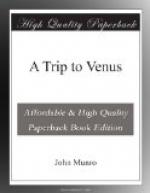“Well,” he replied, “Mars is evidently inhabited; but so is Venus, probably, and of the two I think you will find her the more hospitable and the nearest. When do you propose to start?”
“Perhaps within six months.”
“We must consider their relative distances from the earth. By the way, I don’t think you have seen my new electrical orrery.”
“An electrical orrery,” I exclaimed. “Surely that is something new!”
“So far as I am aware; but you never know in these days. There is nothing new under the sun, or even above it.”
So saying, he opened a small door in the side of the observatory, and, ushering me into a very dark apartment, closed it behind us.
“Follow me, there is no danger,” said he, taking me by the arm, and guiding me for several paces into the darkness.
At length we halted, and I looked all around me, but was unable to perceive a single object.
“Where are we?” I enquired; “in the realms of Chaos and Old Night?”
“You are now in the centre of the Universe,” replied Gazen; “or, to speak more correctly, at a point in space overlooking the solar system.”
“Well, I can’t see it,” said I. “Have you got such a thing as a match about you?”
“Let there be light!” responded Gazen in a reverent manner, and instantly a soft, weird radiance was over all. The contrast of that sudden illumination with the preceding darkness was electrical in more senses than one, and I could not repress a cry of genuine admiration.
A kind of twilight still reigned, and after the first moment of surprise, I perceived that we were standing on a light metal gangway in the middle of a great hollow cell of a luminous black or dark blue colour, relieved by innumerable bright points, and resembling the night sky in miniature.
“I need hardly say that is a model of the celestial sphere,” whispered Gazen, indicating the starry vault.
“It is a wonderful imitation,” I responded, my awestruck eyes wandering over the mysterious tracts of the Milky Way and the familiar constellations of the mimic heavens. “May I ask how it is done—how you produce that impression of infinite distance?”
“By means of translucent shells illuminated from behind. The stars, of course, are electric lamps, and some of them, as you see, have a tinge of red or blue.”
Most of the light, however, came from a brilliant globe of a bluish lustre, which appeared to occupy the centre of the crystal sphere, and was surrounded by a number of smaller and fainter orbs that shone by its reflected rays.
“This, again, is a model of the solar system,” said Gazen. “The central luminary is, of course, the sun, and the others are the planets with their satellites.”
“They seem to float in air.”
“That is because their supports are invisible, or nearly so. Both their lights and periodic motions are produced by the electric current.”




